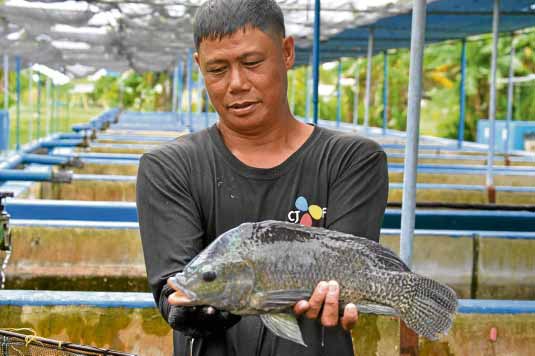Preserving ancestors of today’s tilapia at CLSU

A 12-YEAR-OLD progeny of a parent tilapia from Ghana is shown by a worker of theNational Freshwater Fisheries Technology Center at the Central Luzon State University in the Science City Muñoz. The sperms of its dead parent are cryopreserved in the center’s sperm bank. ANSELMO ROQUE/INQUIRER CENTRAL LUZON
SCIENCE CITY OF MUÑOZ—The ancestors of the modern tilapia strain grown and harvested here and in other Asian countries are all gone.
But their sperms live on in five liquefied gas containers in a room at the National Freshwater Fishery Technology Center (NFFTC) of the Central Luzon State University (CLSU) here.
The cryo preserved tilapia sperms can be retrieved anytime for crossbreeding to produce new tilapia strains.
The parents were considered the best performing Nile tilapia gathered from Egypt, Kenya, Senegal, Ghana, Israel, Singapore, Taiwan and Thailand. They were used for 64 crossing combinations from which excellent performing tilapia strains were selected, developed and commercially produced in huge volumes cycle after production cycle.
“The sperms were placed in plastic straws and are frozen in minus 196 degree Celsius,” said Ma. Jodocel Casayuran-Danting, officer in charge of the NFFTC.
Danting was a member of the team that started in 1993 the cryo preservation project that paved the way for the establishment of a Tilapia Germplasm Collection building which also houses an artificial incubation facility and a wet laboratory.
Adjacent to the facility are 35 concrete tanks from where the foundation stocks are produced and propagated in ponds to build breeder stock. One of these tanks keeps a 12-year-old, two-kilogram live tilapia, which is a progeny of the original stock from Ghana.
“These sperms are also useful in checking the defects of foundation stocks of fish seeds (eggs, larvae, and fries) which produce the fingerlings for commercial production,” Danting said.
The tilapia is native to Africa. The most famous freshwater fish now being cultured in many countries is the Nile tilapia (Oreochromis niloticus).
The aquaculture of Nile tilapia dates back to ancient Egypt. It was one of the three main types of fish caught in Biblical times from the Sea of Galilee.
Called Amnoon in Hebrew (mother fish), it is called Musht (comb, because of its comb-like backfin) in Arabic or its other Biblical allusion “St. Peter’s fish.”
Mozambique tilapia (O. mossambicus) was introduced in the Philippines in 1950, according to fishery scientists. It was not widely accepted due to its dark color and small size. It was considered by fish growers as a pest in their fishponds because it matured early and tended to overcrowd production areas.
In the early 1970s, the introduction of the light-colored Nile tilapia improved the image of tilapia and boosted commercial production in the country.
Thus, it can help solve the problem of fry shortage. It is also an efficient converter of water foodstuff.
Tilapia has a short food chain because it is a plankton feeder, can easily adapt and is highly resistant to adverse conditions. It is resistant to diseases, has a good eating quality, and is relatively cheaper in the market.
Over time, however, its quality deteriorated. To improve its strain, the International Center for Living Aquatic Resources Management (ICLARM), which was formed in the Philippines in 1987, established partnership with other agencies like NFFTC and started developing the Genetically Improved Farm Tilapia (GIFT).
The project required a shipment of 2,000 units of Nile tilapia from Egypt, Ghana, Kenya and Senegal. These were kept at the NFFTC quarantine facilities and became the stock for the crossbreeding or hybridization project.
The resulting strain made tilapia farming popular in the Philippines and in 11 other Asian countries to which the new strain was distributed.
But to perpetuate the genes of GIFT’s forebears, tilapia grandparents were preserved in a gene bank described by fish scientists as “one of the most valuable gene banks” in the world.
After GIFT, NFFTC produced the GET-Excel (acronym for excellent genetically enhanced tilapia) strain that has become the core of the Philippine tilapia breeding program.
“We have also come up with the ‘I-Excel’ or improved GET-Excel strain. Breeders of this strain are now being distributed in technology outreach stations, central hatcheries, and accredited breeding stations,” Danting said.
Due to the improved strains of tilapia, commercial production in the country increased dramatically. From 81,954 metric tons (mt) in 1995 it shot up to 163,003 mt in 2005.
In 2015, total production in volume was 311,690 mt, which was second to bangus’ (milkfish) 392,740 mt volume.
Globally, according to former Agriculture Secretary Proceso Alcala, the Philippines was ranked fourth in 2014 in terms of tilapia production, after China, Indonesia and Egypt in that order.